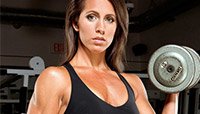What if the amount of food or the choices you put in your mouth could be scientifically tracked, calculated, and make your weight loss the easiest no-brainer you've done all year? No, this is no 'magic pill' advertisement or 4-easy-payments exercise equipment commercial. We're talking about math.
Ugh, right? Who wants to read an article about math? You do! Wouldn't you rather endure a little math upfront to know exactly how many specific calories your body needs to take in from fat, protein, and carbs to ensure maximum weight loss without any "magic pills", starvation plans, and it all be tailored just for your specific body?
How Much Should You Be Eating?
First, we'll determine the number of calories you burn while at rest, or your Basal Metabilic Rate (note the different equation for men and women). Take your current weight in pounds, divide it by 2.2, and that's your weight in kilograms.
Next, take your height in inches, and multiply it by 2.54 to find your height in centimeters. Now, let's find how many calories you must consume to meet your daily caloric requirements (Source: What Does Your Doctor Look Like Naked by Dr. Warren Willey).
- For Males: 66.5 + (13.75 x weight in kg) + (5.003 x height in cm) - (6.775 x age in years)
- For Females: 655.1 + (9.563 x weight in kg) + (1.850 x height in cm) - (4.676 x age in years)
Next, we're going to divide up the allotted calories in your day into the three main sections you should be tracking: protein, carbohydrates, and fat. 40% of your calories will come from protein, 40% will come from carbs, and 20% will come from fats. This ensures you'll have a proper balance of everything your body needs to shed the weight (and keep it off).
To get your protein and carbohydrates requirements, you'll take your daily caloric requirements number and multiply that by .4 (40%), then take that number and divide it by 4 (because there are 4 calories in a gram of protein and 4 in a gram of carbs). Now, on to the fats. Take your daily caloric requirements number and multiply that by .2 (20%), then take that number and divide it by 9 (because there are 9 calories in a gram of fat).
That doesn't include the burning of calories during your workout, or tell you how much to eat at each meal. There's a little bit more math to go, stay with me!
Next, we need to figure out how many calories you burn while lifting weights (and regardless of whether you're a man or woman, if you want the best, healthiest, and most enjoyable way to sculpt your body, you should be lifting weights). Take .086 (weight lifting variable) x your weight in kg x number of minutes you spend in the gym.
Having this information at your disposal is only as good as you make it. What you choose to do with it determines whether you keep the spare tire or lose it for good.
Get a food journal. Even a cheap notebook would suffice. Log every single thing you eat, all the way down to the amount (either in grams or ounces). Find out how many calories are in the foods you eat.
Use your food journal to track exactly how much you've eaten in each category: calories, protein, carbs, and fat. You'll be able to accurately predict what the scale should say the following week.
Conclusion
The most important thing is to be honest. Eating a bag of potato chips when no one else is looking or scarfing down a piece of cake that no one else will ever know about still counts against your daily caloric intake.
Remember, those abs you see in the magazines were made in the kitchen, not the weight room. You want wear a single-digit dress or pant size? You have to do the math first!
Recommended For You

Burn Fat And Build Shape With Strength Training!
Watch your diet to reveal your shape, and strength train to improve that shape. This is classic advice, but many of us have a hard time putting it into practice. Coach Nick Tumminello is here to help!
17 Tips To Help You Lose Fat Faster!
Losing fat is no easy feat, but a little pro advice can go a long way. Check out these 17 blubber-banishing tips and supercharge your shred!
